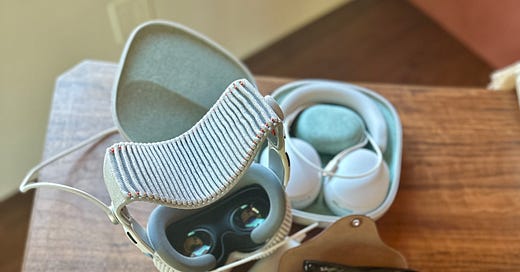My pile of unused devices
I got overly excited about the future of personal devices and spent a lot of our firm's money buying them this year! But there is a tantalizing possibility in the pile.
I bought a lot of devices this year to investigate if there was something happening in the personal-device domain. Conclusion? Not really. Well, maybe…
You’ve read about a lot of these devices. They are widely reviewed. I bought the following (linked to a good review). Apple Vision Pro; Humane AI Pin; and the Sol Reader. I didn’t buy the Rabbit R1. I haven’t received the Brilliant Labs AI Frames or the G1 from Even Realities, both of which I did order and am looking forward to trying out.
I also bought the Oura Ring 3 and the latest Apple Watch as well as the Meta Rayban Wayfarer; the photo includes all the devices I did buy and didn’t end up using.
Here’s the conclusion: Most of this doesn’t lead anywhere, but the Meta Rayban glasses might and the peak into that future is partly visible through the Brilliant and Even Realities AR glasses.
Obviously, the Oura Ring and the Apple Watch are successful devices commercially, even to the point that Google and Samsung and others are copying them because they believe there is a market to be had. I did use both of them for several months. But ultimately I stopped using them because of the charging problem. All electronic devices have batteries that need to be charged, and that’s big price to pay for whatever value you get. Smartphones are worth charging overnight every night, so are ear buds. But Oura and Apple Watch didn’t cut it for me.
A lot of the products in the pile are just not useful. Apple should abandon Vision Pro; it’s cool tech but it isn’t a product and has obviously failed in the marketplace. I don’t need to say anything about Humane AI Pin, except that Apple people should stay inside Apple and enjoy the comfy cult rather than trying to start companies. (Ever heard of Syng?) And my mentioning the Sonos Ace headphones is gratuitous, since I love Sonos products (and served on the board early on). They are cool and less expensive than Apple’s overpriced AirPods Max, but still not useful given their size and the charging problem.
The Meta Rayban glasses are in the pile (as was the original version), but it is the most interesting device in the bunch. Watch Marques Brownlee’s review of the glasses to get the lowdown. It’s in the pile because it doesn’t cut it now if you don’t already wear glasses. But the next version will be the one that really makes it worth wearing glasses if you don’t already wear them, like me. Maybe. It might be the next version after the next one or the one after that.
Our firm is totally into this domain and has invested in two particularly relevant companies, Niantic Labs (creator of PokemonGo, Monster Hunters and Pikmin Bloom, the only real AR games so far, but only on smartphones, plus its Lightship platform for AR apps) and Digilens, which makes components for AR glasses. If it is possible to pull all these things together into fashionable glasses that show you stuff on the glass while you can still see through them… That gets really interesting as a possible new product category. Indeed, imagine wearing a pair of glasses that you could play PokemonGo on plus what the Meta Rayban glasses do now and will do in the future.
Right now the betting is that Meta Rayban will get there first, once they make their AI assistant more reliable, make the internet connection more robust and add the projection-on-glass features, all without making the glasses dorkier, heavier or harder to charge. Maybe Apple could learn from the Vision Pro and make better glasses sooner? After all, Tim Cook has consistently promoted AR over VR. Or another company? It doesn't feel like Google, Microsoft or Samsung are in the game at all. It also doesn’t seem like the thing that startups like Brilliant or Even Realities can pull off (which is why we invested in a component technology rather than a consumer product).
I’m betting on Meta getting there first. The company seems to be on the game, which indicates that the current glasses are selling well enough to warrant more investment. Today it announced it is shutting down Meta Spark, “shifting resources to the next generation of experiences, across new form factors like glasses”.





Couldn't agree more. I was having brunch with a Meta exec a couple of Sunday's ago and I was lobbying him to get me the Meta Raybans to play with. He declined saying "I don't want you to be disappointed! But you will really like what's coming next!" Maybe something fun and useful is coming. Nothing would make me happier than to have glasses that I could wear that would identify a person coming towards me and remind me how I might know them. That for me would be a brilliant use of AI.
Feels like Vision Pro is twenty years early, as the Newton was before iPad. Simple things: Weight, Cumbersomeness, Price.
I’m long on Spatial Computing but wondering if BCIs will “take the win” by evolving faster than AR can miniaturize into glasses while offering the full Spatial Compute experience. In other words, will the winner be on-eye/on-face hardware, or neurohardware?